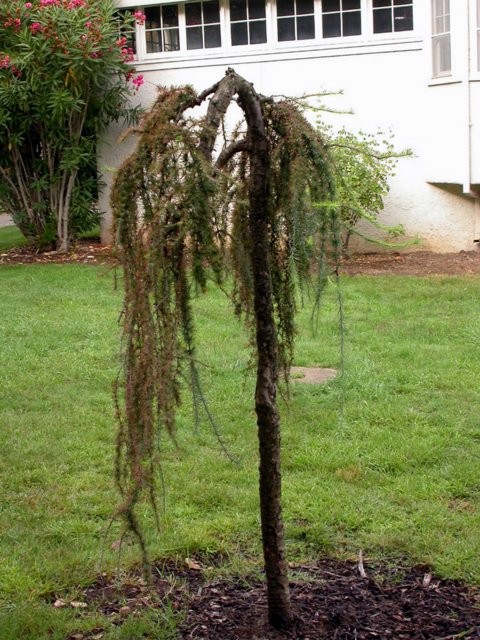Larix × eurolepis
 Dunkeld larch
Dunkeld larch
Various species of larch are distributed widely in the circumarctic forests, some extending as far south as the Pacific Northwest and the Atlantic Northeast. The larch is a tree of many uses: house framing, railroad ties, shipbuilding, pilings (as at Venice), telephone poles, turpentine production, and the manufacture of baking powder. In the British Isles Larix decidua is the most planted exotic tree. Larch is also a widely valued and versatile ornamental, and is used for street planting in cold mountainous places. It is deciduous, unlike most conifers.
Dunkeld larch was discovered at Scotland’s Atholl Estates after a group of Japanese larch (L. kaempferi), imported in 1885 by the 4th duke, were pollinated by the nearby European species (L. decidua) in the estate’s commercial woodlands. A disoriented hybrid (L. ‘Varied Directions’) of Dunkeld larch was in the circular island at the south end of the Braun Music Center archway; it did not survive and was removed in winter 2009. It exhibited the characteristic well-spaced tufts of short needles. When the leaves fell there was a display of charming, upright, 1-inch cones whose scales follow the Fibonacci pattern. If a twig were collected, the dark winter buds could be used to study the larch’s spiral phyllotaxy.
A drooping L. decidua ‘Pendula’ on the east side (in back lawn) of Harmony House off Lomita Drive succumbed as well, and was removed in winter 2009.
A graceful Japanese larch (L. kaempferi) may be seen in Hakone Gardens in Saratoga, near the southeastern edge of the koi pond.
About this Entry: The main text of this entry is from the book Trees of Stanford and Environs, by Ronald Bracewell, published 2005. John Rawlings added the Pendula information and noted the removals ca. 2009. Minor edits (Jan 2018, SP). Hakone location added; minor edits (Aug 2023, SP). L. × eurolepis now the main heading (Jan 2024, SP).





